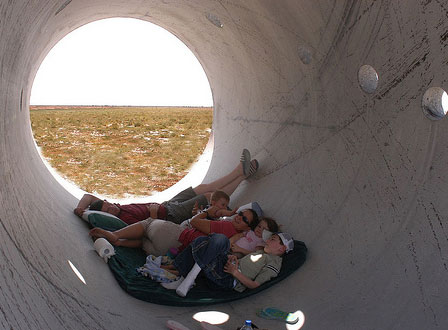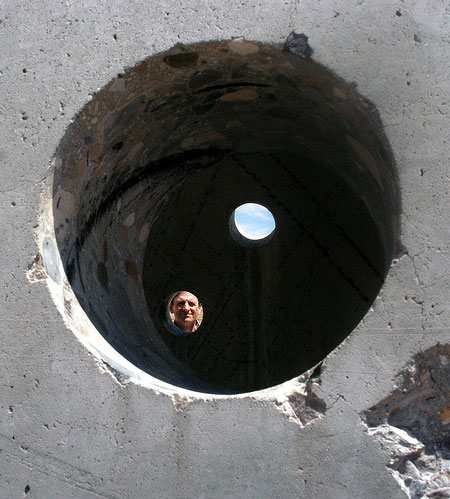
"Family relaxing" in Nancy Holt's Sun Tunnels sculpture - from listorama's flickr (found on google maps)

another shot from listorama
Recent reading (as in books, paper ones):
1. Richard Stark's "Parker" novels slug you in the gut and walk away. The stories, being republished by U. of Chicago press, have new forwards by John Banville and Luc Sante in the proud tradition of explaining to dumb Americans how good their "popular" writers are. The adventures of an amoral heister who, like the author, has everybody's number. Just learned from Wikipedia that the Godard movie Made in USA was based on The Jugger. The late Donald Westlake (Richard Stark's real identity) sued to stop distribution in America. Wikipedia is silent on whether the movie's belated release stateside had anything to do with Westlake's death.
2. Donald Westlake's "Dortmunder" novels. More trifling than the Parker books but amusing for their in-depth New York locations.
3. Gene Wolfe's Book of the New Sun. 800 pages of literary scientifiction puzzlement set in a dying Earth landscape. This is considered a classic but I wonder how much appeal it has outside the hard core of genre readers. Much of the draw is figuring out which tropes (laser weapons, dimensional gates, neurological drugs) are being described by the ignorant, unreliable narrator in this post-apocalyptic medieval setting. Wolfe's visual imagination (strangely claustrophobic and inward-looking even when the vistas are soaring) and his oddball archaic language (based on historical research rather than the usual penchant for calling aliens names like "Qwarlo") keep you reading.
4. Kingsley Amis, One Fat Englishman. The friend who lent me this tells me it is Amis' self-caricature. In the mold of Evelyn Waugh's The Loved One and Nabokov's books where a sophisticate from across the pond recoils in horror at American slick empty-headedness. Roger Micheldene, the narrator, offers no alternative: for all his verbal dexterity he is a consummate horse's ass. I found myself looking forward to Micheldene's sparring with a young beat-ish writer, who is also a jerk.
A science story from ABC News's website about deadly human-eating pythons in the Everglades:
ABC tells us we should be very afraid of a hybrid between African rock pythons, which have been found in the Everglades swamps and are homicidal, and the more gigantic Burmese pythons, also residing in the swamps but not bothering humans, even though it "remains a big question" whether the two species "could produce fertile offspring."
There's nothing scarier than the things you guess might be out there. Definitely newsworthy.
Below is a positive prereview of an upcoming installation work by Rafael Lozano-Hemmer, written by Rhizome.org's resident psychics.
When artist and curator Hilla Rebay hung Vasily Kandinsky’s paintings at the Museum of Non-Objective Painting, which she convinced her lover Solomon R. Guggenheim to open in the late 1920s, she created a sensual environment for them with colored walls, faint music, and perfumed air. It was an approximate construction of an inner, spiritual harmony unencumbered by reminders of nature, in keeping with the ideas of Kandinsky’s influential tract "Concerning the Spiritual in Art." While multimedia updates of art from an older period risk becoming mere bells and whistles on a body of work that stands on its own merits, Kandinsky’s intense interest in synaesthesia—and his exhibition history with Guggenheim’s collection—make it seem like he might be sympathetic to opportunities for multiple sensory stimulation afforded by today’s data processing technologies. Perhaps that’s why Works & Process at the Guggenheim Museum commissioned an immersive light-and-sound piece from Rafael Lozano-Hemmer to mark the opening of the museum’s major Kandinsky retrospective, the first for the artist in more than twenty years. Levels of Nothingness, which Lozano-Hemmer developed in collaboration with philosopher Brian Massumi, takes its inspiration from Kandinsky’s 1912 essay "Yellow Sound." The installation generates visuals from phonetic data produced by reading philosophical texts by Kandinsky and others. (At the performance, Isabella Rosselini will kick off the readings, and audience members will be encouraged to continue). Rather than translating one kind of information into another to spell out a neatly servable (sic) metaphor—as Lozano-Hemmer did, for example, with Pulse Park, which presented Madison Square Park as a living organism by animating it with lights activated by the heart rates of passers-by—Levels of Nothingness promises to be more meditative and fuzzy, suggesting the connection between thought and feeling, or objectivity and subjectivity that the writers it featured tried to put in words. When visualization is so commonly used as a tool to clear things up, it’s encouraging to see artists using it as a way to hint at the murky and unknowable. (emphasis added)
It's not clear who has the greater foreknowledge here: the writer of the review or Kandinsky himself, speaking from beyond the grave. In any case, hearing about a light show triggered by a movie star reading a painter's writings makes it seem like a situation where we might be unsympathetic to the opportunities for enjoyment it affords. (See also - "Avant Garde Establishment.")
Updated: Edited to be more in line with a series-in-progress on predictive criticism.
"Pretty Killbots" [mp3 removed]
Continuing series where live analog synth passages are augmented with more "scripted" rhythms and/or melodies. As the title suggests the idea here was to wed the heavenly and the obnoxious. The tune from "Miasmatic Wave Crunch," played here with an e-piano and a video-gamy sampled Sidstation patch, is layered over some doomy analog grunts and complaints. The melody got boring after a few repetitions so I was forced to write some variations and counterpoint--darn, that's hard--so the song now has a narrative arc.